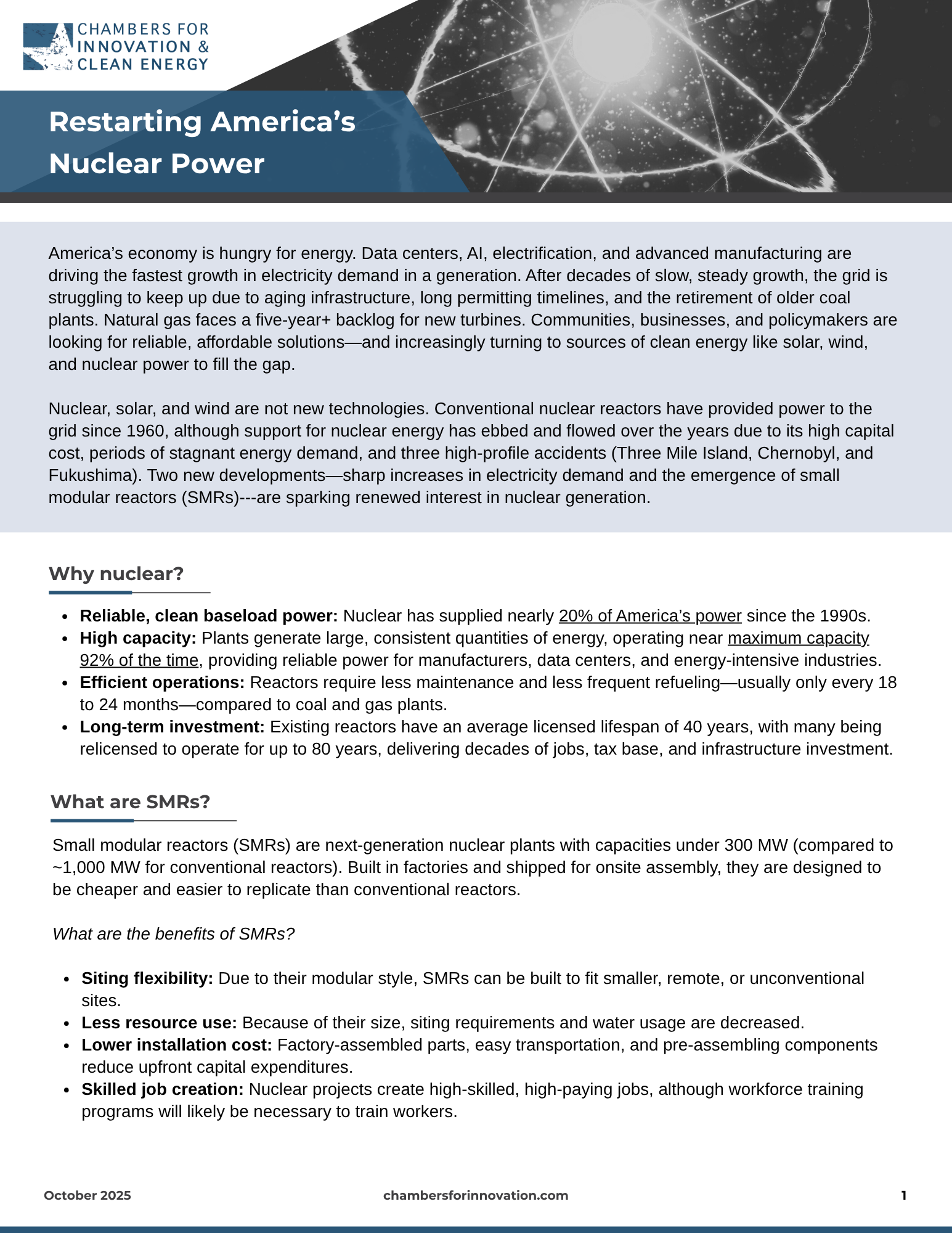Research
Restarting America’s Nuclear Power
America’s economy is hungry for energy. Data centers, AI, electrification, and advanced manufacturing are driving the fastest growth in electricity demand in a generation. After decades of slow, steady growth, the grid is struggling to keep up due to aging infrastructure, long permitting timelines, and the retirement of older coal plants. Natural gas faces a five-year+ backlog for new turbines. Communities, businesses, and policymakers are looking for reliable, affordable solutions—and increasingly turning to sources of clean energy like solar, wind, and nuclear power to fill the gap.
Nuclear, solar, and wind are not new technologies. Conventional nuclear reactors have provided power to the grid since 1960, although support for nuclear energy has ebbed and flowed over the years due to its high capital cost, periods of stagnant energy demand, and three high-profile accidents (Three Mile Island, Chernobyl, and Fukushima). Two new developments—sharp increases in electricity demand and the emergence of small modular reactors (SMRs)---are sparking renewed interest in nuclear generation.
Why nuclear?
Reliable, clean baseload power: Nuclear has supplied nearly 20% of America’s power since the 1990s.
High capacity: Plants generate large, consistent quantities of energy, operating near maximum capacity 92% of the time, providing reliable power for manufacturers, data centers, and energy-intensive industries.
Efficient operations: Reactors require less maintenance and less frequent refueling—usually only every 18 to 24 months—compared to coal and gas plants.
Long-term investment: Existing reactors have an average licensed lifespan of 40 years, with many being relicensed to operate for up to 80 years, delivering decades of jobs, tax base, and infrastructure investment.
What are SMRs?
Small modular reactors (SMRs) are next-generation nuclear plants with capacities under 300 MW (compared to ~1,000 MW for conventional reactors). Built in factories and shipped for onsite assembly, they are designed to be cheaper and easier to replicate than conventional reactors.
What are the benefits of SMRs?
Siting flexibility: Due to their modular style, SMRs can be built to fit smaller, remote, or unconventional sites.
Less resource use: Because of their size, siting requirements and water usage are decreased.
Lower installation cost: Factory-assembled parts, easy transportation, and pre-assembling components reduce upfront capital expenditures.
Skilled job creation: Nuclear projects create high-skilled, high-paying jobs, although workforce training programs will likely be necessary to train workers.
What is the status of SMRs?
SMRs are still an emerging technology. More than 80 designs are under development globally, but only two are operational today: Russia’s 35 MW floating SMR (2020) and China’s 210 MW reactor (2021). As of September 2025, the U.S. has no SMRs in operation or under construction, and none are expected online before 2030.
Growing federal and state support
Momentum is building for nuclear as part of a long-term energy strategy.
Recent executive orders have reorganized the Nuclear Regulatory Commission, restarted reactor testing at the Department of Energy, advanced new fuel research and workforce development, and set a national goal of quadrupling nuclear capacity from 97 GW to 400 GW.
The Department of Energy has launched a Reactor Pilot Program to test advanced reactor designs, with the goal of having at least three concepts ready by 2026. Eleven projects have already been selected for a fast track to future commercial licensing.
20 states have formed a nuclear consortium to encourage investment, accelerate projects, and craft supportive policies. These states see nuclear as a strategic investment for both energy security and economic growth.
The challenges ahead
Even with a more supportive regulatory environment, the timeline for nuclear is still long and uncertain. NuScale’s demonstration SMR in Utah illustrates this reality: first proposed in 2014 at $3.6 billion for 720 MW, it was cancelled in 2023 after costs ballooned to $9.3 billion for just 462 MW, driven by overruns and supply chain shortages.
Conventional reactors can take 15 years to move from permitting to construction. And since SMRs are still developing, no SMR is expected to enter service before 2030, with electricity demand expected to rise 25% in the interim.
Meeting demand while planning for tomorrow
Although SMRs show long-term promise as a clean, reliable form of baseload power, they simply aren’t available to meet today’s surging energy needs. New gas turbines face a five-year backlog, and coal is no longer financially viable. That leaves utility-scale solar and wind as the most affordable and fastest-to-market options, often completed in less than two years. Battery storage can help meet peak demand by storing energy during low-use periods and releasing it during high-demand hours. Federal permitting reform and state and local siting reform are essential to accelerate nuclear, solar, and wind projects and ensure communities remain competitive as demand rises.

